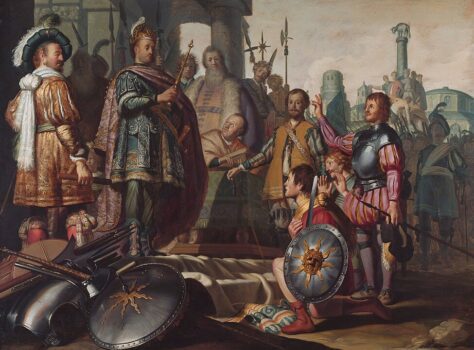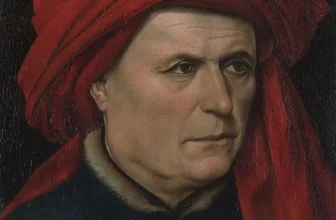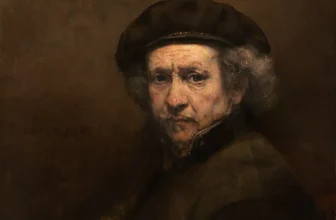Meaning of “History Painting” by Rembrandt van Rijn
Among the pantheon of Dutch Golden Age painters, Rembrandt van Rijn (1606–1669) stands out as an unparalleled master of dramatic composition, nuanced lighting, and psychological depth. Known for his prolific output, Rembrandt’s work spanned self-portraits, biblical scenes, landscapes, and genre paintings. One of the more enigmatic pieces in his early career is a painting known simply as “History Painting”, an ambitious, grand composition created in 1626. Though lesser-known than some of his masterpieces like The Night Watch or The Anatomy Lesson of Dr. Nicolaes Tulp, “History Painting” offers profound insight into Rembrandt’s emerging style and intellectual aspirations.
But what exactly is the “History Painting”? What does it depict, and why does it continue to intrigue art historians and critics? Let’s delve deep into the painting’s meaning, execution, symbolic undertones, and modern-day relevance.
What is “History Painting” by Rembrandt van Rijn?
Titled rather generically as “History Painting,” the work was created in 1626, when Rembrandt was only around 20 years old. The title is not one assigned by Rembrandt himself but rather a placeholder, as the actual subject of the painting remains uncertain. Over the years, various scholars have attempted to identify the scene, suggesting interpretations ranging from Biblical stories to Classical and Medieval themes. Despite the ambiguity, the painting is a testament to Rembrandt’s early ambition, an attempt to enter the highest genre in the academic hierarchy of painting: history painting.
In the 17th century, history painting was considered the most prestigious genre of art. Unlike portraiture, still life, or landscape, history painting required the artist to depict scenes from historical, mythological, literary, or religious sources. These works were expected to convey universal moral or philosophical truths, often involving complex narratives and large groups of figures in dramatic poses.
Thus, Rembrandt’s “History Painting” is more than just an image, it is a statement of artistic intention, a declaration that the young artist was capable of tackling the most sophisticated themes.
Visual Description and Composition
“History Painting” (1626) measures about 90 x 120 cm and is executed in oil on panel. The scene is set in a large, stage-like architectural setting, featuring a complex grouping of over a dozen figures, each carefully posed and rendered with individualized expression.
At the center of the composition is a regal, seated figure who appears to be an authoritative ruler or perhaps a judge. He holds a scepter and gestures towards a kneeling figure, suggesting an act of supplication or appeal. Flanking them are various attendants, courtiers, and guards. To the left, a figure in bright red garb draws attention, perhaps a signifier of conflict or sacrifice. To the right, figures appear to react emotionally to the central drama, adding dynamism and tension to the tableau.
The architectural setting, with its columns, staircases, and elevated platform, contributes to a sense of grandeur and theatricality. Rembrandt shows early signs of his mastery in handling chiaroscuro, the dramatic interplay between light and shadow that he would later become famous for. The light source seems to come from the upper left, illuminating the central action while casting peripheral figures into shadow.
What is Happening in the Painting?
One of the most fascinating aspects of “History Painting” is the uncertainty surrounding its subject matter. Unlike many of Rembrandt’s other works where the narrative is clear (such as The Return of the Prodigal Son), this piece presents a tableau that does not correspond directly to any well-known story.
Several theories have been proposed over the years:
The Continence of Scipio – This ancient Roman tale tells of the general Scipio Africanus returning a captured young woman to her fiancé and family, an act of moral virtue. Some art historians believe the kneeling woman and regal central figure might support this interpretation.
Palamedes before Agamemnon – Another popular interpretation suggests a scene from Greek mythology where Palamedes, accused unjustly by Odysseus, pleads his case before Agamemnon. This would fit with the themes of justice and betrayal.
A Biblical Scene – Others propose that it might be a scene from the Apocrypha or lesser-known Biblical episodes, possibly involving King Solomon or a prophet.
Despite these attempts at identification, no consensus has been reached, and the painting continues to be referred to simply as “History Painting.”
Symbolism and Deeper Meaning
While the exact narrative remains elusive, the painting nonetheless conveys several clear symbolic and thematic messages:
1. Justice and Mercy
The central act of the ruler gesturing towards the kneeling figure suggests a judgment scene, possibly an act of clemency, mercy, or final verdict. This theme of justice would have resonated with Dutch audiences in the early 17th century, a time when the newly independent Dutch Republic was establishing its own legal and moral codes.
2. Moral Virtue
If the painting does depict a classical story like Scipio or Palamedes, it reflects Rembrandt’s early engagement with themes of virtue, restraint, and ethical conduct, hallmarks of the humanist tradition that valued moral exemplars from antiquity.
3. The Theater of Power
The elevated platform, the elaborate costumes, and the courtly setting emphasize hierarchy and power dynamics, inviting viewers to reflect on the mechanisms of authority. In an era of burgeoning civic governance and debates over monarchy and republicanism, these visual cues were deeply symbolic.
4. Emotional Diversity
One of Rembrandt’s most innovative traits was his ability to capture human emotion. Even in this early work, each figure seems to react differently to the unfolding drama, some are anguished, others curious, still others impassive. This spectrum of emotion suggests a humanist sensitivity to the complexity of human responses and interactions.
How “History Painting” Was Painted: Technique and Style
Despite his youth, Rembrandt’s technical skill in the painting is remarkable. His use of oil on panel allows for both precise detail and layered textures. A few notable techniques can be observed:
1. Chiaroscuro
Though still developing his signature style, Rembrandt already shows a keen understanding of light and shadow. The central figures are bathed in warm, directional light that draws the eye and builds dramatic tension.
2. Impasto and Brushwork
Rembrandt uses thick layers of paint (impasto) in key areas to add texture, particularly in the fabrics and architectural elements. The brushwork is fluid and confident, suggesting he was already thinking of paint as a medium for expressive storytelling rather than just illustration.
3. Anatomical Realism
The rendering of human anatomy, hands, faces, and posture, is highly detailed. Each figure feels grounded and believable, a quality that would later make his Biblical and portrait works so emotionally resonant.
4. Color and Costume
The use of rich reds, golds, and deep blues enhances the sense of opulence. Rembrandt pays close attention to costuming to differentiate roles, rulers, courtiers, soldiers, adding layers of narrative without needing textual explanation.
What Type of Art is “History Painting”?
“History Painting” belongs squarely in the Baroque period, characterized by grandeur, movement, and theatrical intensity. More specifically, it is an example of history painting, the highest genre in the academic hierarchy of Western art, which included:
Religious painting
Mythological subjects
Historical narratives
Allegorical scenes
In this context, Rembrandt’s painting demonstrates his early attempt to establish himself as a serious, intellectually driven artist. Unlike genre scenes or portraits that focused on the here-and-now, history painting required imagination, erudition, and a capacity to visualize universal truths through narrative.
Where is the History Painting Today
Today, Rembrandt’s “History Painting” is housed in the Rijksmuseum in Amsterdam, one of the premier institutions for Dutch art and history. It was acquired by the museum due to its importance as a key early work in Rembrandt’s oeuvre. Though it might not command the same public attention as his later masterpieces, art historians and scholars frequently study it for what it reveals about Rembrandt’s artistic development, intellectual ambition, and narrative skill.
Importance
Though often overshadowed by Rembrandt’s later masterpieces, “History Painting” (1626) is invaluable in understanding his artistic trajectory. It reveals:
A young artist striving for mastery in the most demanding genre of his time.
A keen intellect capable of tackling complex narratives.
A command of technique that foreshadowed his mature genius.
Perhaps most importantly, the painting stands as a metaphor for artistic ambition itself, a declaration that Rembrandt van Rijn was ready to take on the grand themes of human history, myth, and morality.
Rembrandt’s “History Painting” remains a fascinating artifact of youthful aspiration and artistic promise. While its exact subject may elude definitive interpretation, the painting offers a profound glimpse into the early mind of a genius who would go on to redefine the possibilities of visual art. It reflects not only the ideals of history painting but also the values of a changing world, one in which artists were not just craftsmen but philosophers, storytellers, and chroniclers of the human condition.
Located today in the Rijksmuseum, “History Painting” continues to captivate and challenge viewers, asking them not only to look but to think, to interpret, and to wonder. In that sense, it fulfills the ultimate aim of history painting, to connect us with timeless truths through the power of image and imagination.




